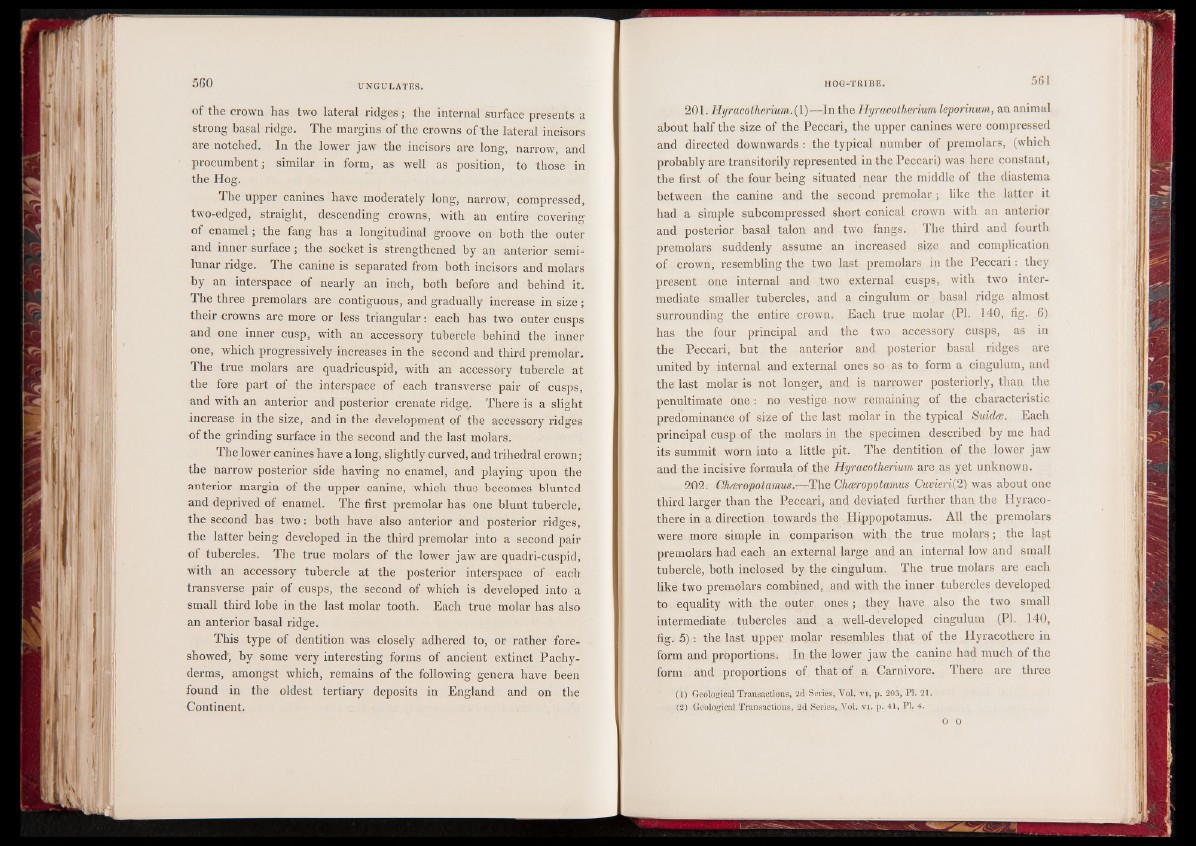
of the crown has two lateral ridges; the internal surface presents a
strong basal ridge. The margins of the crowns of the lateral incisors
are notched. In the lower jaw the incisors are long, narrow, and
procumbent; similar in form, as well as position, to those in
the Hog.
The upper canines have moderately long, narrow, compressed,
two-edged, straight, descending crowns, with an entire covering
of enamel; the fang has a longitudinal groove on both the outer
and inner surface; the socket is strengthened by an anterior semilunar
ridge. The canine is separated from both incisors and molars
by an interspace of nearly an inch, both before and behind it.
The three premolars are contiguous, and gradually increase in size;
their crowns are more or less triangular: each has two outer cusps
and one inner cusp, with an accessory tubercle behind the inner
one, which progressively increases in the second and third premolar.
The true molars are quadricuspid, with an accessory tubercle at
the fore part of the interspace of each transverse pair of cusps,
and with an anterior and posterior crenate ridge,. There is a slight
increase in the size, and in the development of the accessory ridges
of the grinding surface in the second and the last molars.
The lower canines have a long, slightly curved, and trihedral crown;
the narrow posterior side having no enamel, and playing upon the
anterior margin of the upper canine, which thus becomes blunted
and deprived of enamel. The first premolar has one blunt tubercle,
the second has two: both have also anterior and posterior ridges,
the latter being developed in the third premolar into a second pair
of tubercles. The true molars of the lower jaw are quadri-cuspid,
with an accessory tubercle at the posterior interspace of each
transverse pair of cusps, the second of which is developed into a
small third lobe in the last molar tooth. Each true molar has also
an anterior basal ridge.
This type of dentition was closely adhered to, or rather foreshowed’,
by some very interesting forms of ancient extinct Pachyderms,
amongst which, remains of the following genera have been
found in the oldest tertiary deposits in England and on the
Continent.
201. Hyracotherium.(1)—In the Hyracotherium leporinum, an animal
about half the size of the Peccari, the upper canines were compressed
and directed downwards : the typical number of premolars, (which
probably are transitorily represented in the Peccari) was here constant,
the first of the four being situated near the middle of the diastema
between the canine and the second premolar; like the latter it
had a simple subcompressed short conical crown with an anterior
and posterior basal talon and two fangs. I he third and fourth
premolars suddenly assume an increased size and complication
of crown, resembling the two last premolars in the Peccari: they
present one internal and two external cusps, with two intermediate
smaller tubercles, and a cingulum or basal ridge almost
surrounding the entire crown. Each true molar (PL 140, fig. 6)
has the four principal and the two accessory cusps, as in
the Peccari, but the anterior and posterior basal ridges are
united by internal and external ones so as to form a cingulum, and
the last molar is not longer, and is narrower posteriorly, than the
penultimate one : no vestige now remaining of the characteristic
predominance of size of the last molar in the typical Suidcs. Each
principal cusp of the molars in the specimen described by me had
its summit worn into a little pit. The dentition of the lower jaw
and the incisive formula of the Hyracotherium are as yet unknown.
202. Cheeropotamus.—The Chceropotamus Cuvieri(2) was about one
third larger than the Peccari, and deviated further than the Hyraco-
there in a direction towards the Hippopotamus. All the premolars
were more simple in comparison with the true molars; the last
premolars had each an external large and an internal low and small
tubercle, both inclosed by the cingulum. The true molars are each
like two premolars combined, and with the inner tubercles developed
to equality with the outer ones ; they have also the two small
intermediate tubercles and a well-developed cingulum (PI. 140,
fig. 5): the last upper molar resembles that of the Hyracothere in
form and proportions( In the lower jaw the canine had much of the
form and proportions of that of a Carnivore. There are three
(1) Geological Transactions, 2d Series, Vol. vi, p. 203, PL 21.
(2) Geological Transactions, 2d Series, Vol. vi. p. 41, PI. 4.
O O